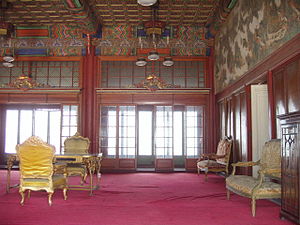Changdeokgung
| Changdeokgung Palace Complex | |
|---|---|
|
UNESCO world heritage |
|

|
|
| Nakseonjae, residence of the royal family |
|
| National territory: |
|
| Type: | Culture |
| Criteria : | (ii) (iii) (iv) |
| Reference No .: | 816 |
| UNESCO region : | Asia and Pacific |
| History of enrollment | |
| Enrollment: | 1997 (session 21) |
| Korean spelling | |
|---|---|
| Korean alphabet : | 창덕궁 |
| Hanja : | 昌 德 宮 |
| Revised Romanization : | Changdeokgung |
| McCune-Reischauer : | Ch'angdŏkkung |
The Changdeokgung (Palace of Brilliant Virtue) is one of five remaining royal palaces from the Joseon Dynasty in South Korea's capital Seoul . In 1997, the palace complex of which was UNESCO as a world heritage site in the UNESCO World Heritage added.
history
The Changdeokgung was built between 1405 and 1412 as the second palace next to the Gyeongbokgung (Palace of Brilliant Happiness), the actual main residence of the Joseon Dynasty, by King Taejong . As it lies east of Gyeongbokgung, Changdeokgung was also called Dongwol (East Palace) until it was set on fire by the warlike Japanese in the Hideyoshi invasion in 1592 and rebuilt 19 years later by the 15th King of the Joseon Dynasty , Gwanghaegun . After being rebuilt, it served as the royal residence and seat of government in 1872. From 1907, Korea's last king, King Sunjong, lived in Changdeokgung . Even after his resignation in 1910 and his death in 1926, the last members of the royal family lived here until 1989. Up to the term of office of the penultimate king, 13 rulers should have lived in the palace.
Between 1910 and 1945, when Korea was a province of Japan , the Japanese language was considered the national language . The Hanja or Kanji of the palace name ( Japanese 昌 徳 宮 ) were therefore pronounced in Japanese, and it was called Shōtokyū at that time .
architecture
The Changdeokgung consists of three areas: the administration area, the living area and the rear garden.
The administrative area includes the Donhwamun main gate, the Geumcheongyo stone bridge, the Injeongjeon audience hall, and Seonjeongjeon, the king's study.
The living area includes Huijeongdang, the king's private apartments, Daejojeon, the queen's private apartments, and Nakseonjae, the last residence of the royal family.
The main attraction of Changdeokgung, however, is the rear (Huwon) or secret garden (Biwon). It is about 32 hectares and blends in harmoniously with the hilly terrain. It houses numerous pavilions, lotus ponds and countless trees, some of which are over 300 years old today.
accessibility
At the beginning of the story, only the head and members of the royal family were allowed to pass the gate and set foot in the " Secret Garden ". Since the palace has ceased to be a ruler's seat in 1872 and was completely renovated in 1907, the entire world population has been allowed to enter the mysterious property, and even visit " The Hall of the Radiant Government " and the imaginative and extensive garden areas that previously only the ruler was allowed to enter.
World Heritage
The Changdeokgung Palace in 1997 following a decision of the 21st session of the World Heritage Committee added to the list of UNESCO world heritage.
The reason for the entry states, among other things:
Changdeokgung is an exceptional example of Far Eastern palace architecture and design, ... in which public and residential buildings have been integrated into their natural surroundings and harmonized with them.
The entry was made on the basis of criteria (ii), (iii) and (iv).
(ii): Changdeokgung has been a major influence on the development of Korean architecture, garden design, landscaping and related techniques over many centuries.
(iii): Changdeokgung exemplifies the traditional principles of Pungsu and Confucianism through its architecture and landscaping. The choice of location and the surrounding area of the palace were based on Pungsu principles, while the buildings were designed functionally and symbolically according to Confucian ideology, which together represent the unique worldview of the Joseon Dynasty.
(iv): Changdeokgung is an outstanding example of East Asian palace architecture and landscaping, which is exceptional for the way in which the buildings are integrated into and harmonized with the natural environment, being adapted to the topography and the covering by Preserve native trees.
reception
A pavilion is the model of the Berlin Pavilion of Unity .
literature
- Friedemann Needy : 1000 wonders of the world. The treasures of humanity in five continents . Naumann & Göbel, Cologne 2000, ISBN 3-625-10560-8 .
- Changdeok Palace . In: World Heritage in Korea . 2011, p. 52–63 (English, online excerpt from Google Books ).
Web links
Individual evidence
- ↑ a b c Changdeokgung Palace Complex. In: whc.unesco.org. UNESCO World Heritage Center, accessed February 6, 2017 .
- ↑ UNESCO World Heritage Center: Decision: CONF 208 VIII.C. In: whc.unesco.org. Retrieved February 8, 2017 .
Coordinates: 37 ° 34 ′ 0 ″ N , 126 ° 55 ′ 0 ″ E




